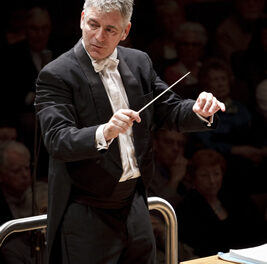The Salisbury Symphony Orchestra opened its 2009-10 season in Keppel Auditorium on the campus of Catawba College with its first classical concert, “Chasing Light.” The theme and title were derived from the final work on the program – more on that later. Music Director David Hagy selected three other works based on the subject of light to complete the theme of the evening.
Opening the program was Symphony No. 7 in C (“Noon”) by Franz Joseph Haydn (1732-1809). One of the striking features of this early symphony is the use of instrumental solos, especially violin and cello, but even double bass, along with numerous wind instruments. The music reflects the brilliance of the midday sun, and the orchestra and soloists danced excitedly in the bright light for a dazzling performance.
Completing the first half of the concert was City of Light, a concerto for clarinet and orchestra, by Persis Parshall Vehar (b.1937), with Eileen Young as soloist. Ms. Vehar is Composer-in-Residence at Canisius College in Buffalo, New York, and wrote this concerto on a commission by the Buffalo Philharmonic. Ms. Young is principal clarinetist with the Salisbury Symphony and principal bass clarinetist in the Winston-Salem Symphony and is on the music faculty of Wake Forest University, where she teaches clarinet, saxophone, and woodwind ensembles.
City of Light celebrates the electrification of city lighting in Buffalo at the beginning of the 20th century. The opening movement is “Flickering in Stained Glass Windows,” evoking the soft glimmer of candles in the church windows. The second movement, “Illumina,” is based on the Gregorian chant Illumina faciem tuam , and the final movement, “The Body Electric,” is taken from Walt Whitman’s poem “I Sing the Body Electric.” Each of the three movements suggests light in some form. This is a very demanding piece for both soloist and orchestra, and both played with great virtuosity. The score calls for some very unusual sounds from the clarinet as well as the orchestra, and Ms. Young made everything seem effortless. Despite its modernity, there are also many parts of this concerto that are quite melodic and lyrical. In all, the work was quite satisfying and was a perfect representation of the concert’s theme.
To begin the second half of the program, Maestro Hagy chose Carl Nielsen’s (1865-1931) “Helios” Overture, which is a tribute to the sun, starting from the dawn, continuing onto noon, and ending at dusk. This is a lush, romantic work, with broad, sweeping strokes of sound. The string, wind, and brass ensembles elicited a magnificent paean to the very light of our existence.
The final work on the program was Chasing Light… by Joseph Schwantner (b.1943). This four-movement symphonic composition was commissioned by Ford Made in America, a consortium of 58 small-budget orchestras, representing all 50 states, the Ford Motor Company Fund, and the National Endowment for the Arts. This is the second time that the Salisbury Symphony has had the honor of being part of this program. More information can be found at www.fordmadeinamerica.org.
Joseph Schwantner is an American composer who has served on the faculties of the Juilliard, Eastman, and Yale music schools. He has received numerous awards and commissions. Chasing Light… is the second commission of the Ford Made in America project, and received its world premiere with the Reno Chamber Orchestra in 2008. This performance is its first in North Carolina.
Chasing Light… is in four movements: “Sunrise Ignites Daybreak’s Veil,” “Calliope’s Rainbowed Song,” “A Kaleidoscope Blooms,” and “Morning’s Embrace Confronts the Dawn.” It gets its spirit and inspiration from the vibrant colors and light of the New England dawn. The work focuses on the colorful sound combinations available in the orchestra, and each segment gradually shifts in a minimalistic style from one set of color combinations to the next. This is a wonderful piece of music, requiring the full forces of a modern symphony orchestra, especially percussion. It is too bad that the percussion section was hidden behind the raised leaf of the grand piano, so that they could not be seen, although there was no question that they were there. The entire orchestra is to be congratulated on its superb performance of this very difficult and demanding piece.
So as to not send the audience out with bright sunlight in the middle of the night, the orchestra shifted gears and played Claude Debussy’s (1862-1918) “Claire de lune,” softly and sweetly, like a lullaby, to end a most extraordinary concert.











